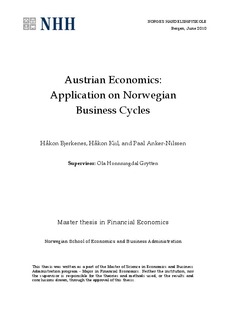| dc.description.abstract | This paper reviews the key elements of Austrian macroeconomics and aims to find out
whether the Austrian business cycle theory can explain causes to Norwegian business
cycles between 1979 and 2009. The Austrian school suggests that monetary
interventions disturb the term structure of interest rates. This causes the capital
structure to change which accounts for fluctuations of the business cycle. Credit-
induced expansions with unchanged time-preferences create unsustainable growth
which inevitably turns the economy into recession. Quarterly time series data of base
money supply, interest rates, investment and private consumption expenditure,
employment, prices, and aggregate output are analysed in order to find relationships
with assumptions of causality. Empirical evidence show that Austrian business cycle
theory can help explain fluctuations in aggregate output for Norway. | en |
